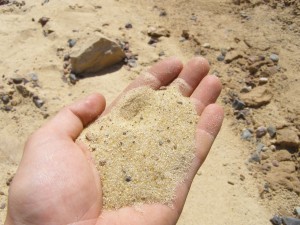A respected freelance writer named Vince Beiser penned a column last summer offering a preview of his coming book on one of the world’s most important but overlooked natural resources, sand. He points out that we use more sand than any other natural resource except water, and perhaps air (though I’m not sure how one measures the air people “use”).
Simply put, sand is the primary ingredient from which all modern cities and towns are made. “Pretty much every apartment block, office tower and shopping mall from Beijing to Lagos, Nigeria, is made at least partly with concrete, which is basically just sand and gravel stuck together with cement. Every yard of asphalt road that connects all those buildings is also made with sand. So is every window in every one of those buildings.”
 Most Americans give very little thought to the resources it takes to maintain a prosperous economy. The Mineral Information Institute keeps track of minerals Americans use, averaging consumption statistics with annual population estimates. The mineral statistics are staggering. The average American will use during their lifetime over 500,000 pounds of coal, six million cubic feet of natural gas, and 72,000 gallons of oil (assuming the same lifestyle we now live). But in addition to energy resources, we also “use” similarly astonishing amounts of copper, clay, lead, zinc, gold, iron, aluminum, salt and numerous other minerals. The list includes well over a million pounds of sand and gravel, and 40,000 pounds of cement needed to turn all that sand into concrete.
Most Americans give very little thought to the resources it takes to maintain a prosperous economy. The Mineral Information Institute keeps track of minerals Americans use, averaging consumption statistics with annual population estimates. The mineral statistics are staggering. The average American will use during their lifetime over 500,000 pounds of coal, six million cubic feet of natural gas, and 72,000 gallons of oil (assuming the same lifestyle we now live). But in addition to energy resources, we also “use” similarly astonishing amounts of copper, clay, lead, zinc, gold, iron, aluminum, salt and numerous other minerals. The list includes well over a million pounds of sand and gravel, and 40,000 pounds of cement needed to turn all that sand into concrete.
This is an issue, Beiser writes, because we are “starting to run out” of sand. That is partly true because the “number and size of cities is exploding, especially in the developing world.” A 2012 UN estimate said the amount of concrete used worldwide would circle the globe with a wall 89 feet high and 89 feet wide. But the blame-America crowd may be shocked to learn that in just the last two years, China used more cement than the United States used in the entire 20th century.
Extracting all that sand is a $70 billion industry, harvesting from desert dunes, riverbeds, floodplains, and especially beaches. And offshore sand dredging depletes available sand that nature otherwise uses to replenish beaches, so the impact is potentially devastating both to economies and environments.
That doesn’t have to be the case, nor must human progress stop in order to save the world’s remaining sand. Many modern environmental writers are quick to call for stronger government regulations to prevent further damage, though most developed countries already have strict rules. But as Beiser points out, that can also dramatically increase the cost of construction, because sand is heavy and expensive to haul. So banning the mining of sand and gravel in our own backyards, as so many community activists want to do, significantly changes the economics of nearly all projects. That can harm the economy, the prospects for new jobs, and the maintenance of roads, bridges, airports, and other vital infrastructure.
I have never been part of the doomsday crowd. I do not think the sky is falling or that we have no choice but to lower our standard of living. Beiser writes that “Hardly anyone thinks about sand, where it comes from or what we do to get it.” That is certainly true, but he goes on to lament that “a world of seven billion people, more and more of whom want apartments to live in and offices to work in and malls to shop in, can’t afford that luxury anymore.” He and other activists just cannot escape the conclusion that all our resources are finite, that we are running out of everything, and that we simply have to stop living such abundant lives.
A better solution is to make more sand, rather than mine it. The process for crushing rock and used concrete is more expensive, but research, innovation, and investment in new technology has never yet failed to provide solutions to seemingly insurmountable problems.
The whole scarcity narrative misses a key point. It may seem counterintuitive, but in fact the development of cities are probably mankind’s greatest tool for environmental preservation. The skyscraper has been called America’s great green gift to the planet, because it packs more people onto less land, leaving vast wilderness undisturbed in the places where most people don’t live. The cities get malls, condos, suburbs, and stadiums, leaving vast expanses of fly-over country for forests, open space, and wildlife.
A version of this column originally appeared in the Grand Junction Daily Sentinel July 1, 2016.




Comments on this entry are closed.